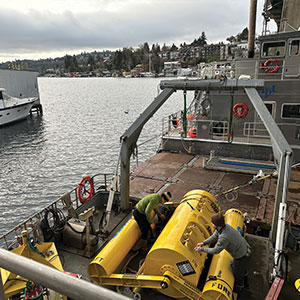Power from water: how C-Power is harnessing an innovative renewable
What comes to mind when you think about waves? Most people will imagine the beach, watching the tide, swimming, or a holiday. Now consider that those very waves could generate sufficient energy to power your house, your business, or even entire cities.
As a world leader in the emerging ocean energy sector, specifically wave energy, C-Power is making that vision possible. Beginning as a graduate research project at Oregon State University, it is building upon decades of research, development, and engineering to deliver ground-breaking solutions that transform the ocean into a power-enriched environment.
“Wave energy is incredibly reliable, as waves are constantly occurring,” begins Reenst Lesemann, CEO at C-Power. “There is less intermittency and seasonality from a renewable’s perspective, so wave energy acts more like baseload power in comparison to wind or solar. Wind and solar are fantastic resources, but there is definitely room and demand for a third dependable renewable resource.”

On a practical level, there are two forces involved in waves – heave and surge – and the combination of these two forces creates the high potential and challenge of harnessing energy from waves. Reenst explains: “From an ocean energy perspective, the ocean is our biggest and best battery. Wave energy comes from wind, and the sun creates wind, so really wave energy is stored solar and wind power.” This creates an incredibly energy-dense resource, so the challenge associated with wave energy is, how do you harness all that power?
“To capture such an intense amount of energy, you have to do three things,” he answers. “We call it the trilemma.” The product must be reliable for stakeholders, regulatory compliant, and affordable. The interplay between those three things is crucial because if you work on only one, it subsequently impacts the other two. “For example, if we only focus on building something super strong or reliable, then it becomes less affordable. C-Power has solved all three aspects of the trilemma simultaneously.
Simply robust
Using this process, C-Power has designed two customer-driven products that are easy to deploy, relatively simple, and cost effective. The SeaRAY Autonomous Offshore Power System (AOPS) provides in-situ power, energy storage, and real-time data for low power offshore needs. The SeaRAY is “A combination of a charging station, a data server and a connection to the data cloud in areas where there is limited or no power,” states Reenst.
The StingRAY is C-Power’s second product, which will deliver cost-effective renewable energy for higher power offshore and onshore needs, as it can produce utility-scale quantities of power. “We have started to commercialize our SeaRAY technology, and the StingRAY will be next in line,” says Reenst, referring to the company’s first sale of the SeaRAY in April 2022 for a U.S. Navy-sponsored research project.
“We aim to have the first StingRAY in the water by 2024, but we have hit the ground running in 2023,” says Reenst. “We have a deployment of a SeaRAY AOPS coming up in Hawaii. We will be running static data gathering systems alongside it to create a power and data mini grid in the ocean. We will also be operating a Saab Sabertooth untethered autonomous underwater vehicle, which will be the first ever instance of an in situ renewable energy system supporting an untethered subsea resident vehicle with power and data communications.”
From market research, C-Power discovered that customers are most concerned with reducing costs, the complexity of their operations, and their carbon-intensity. “Our view originally was that generation capacity was the primary need,” Reenst continues, “But we must listen to our customers because they drive our business!” As a result, simplicity, loss mass, robust communications support, and ease of deployment are central to the company’s designs: “We use a simple mooring system, and a single conversion in our drive train, going straight from the captured wave energy and converting it to useable energy,” he adds.
Power innovation

On a more personal note, Reenst joined the company in its early stages and instantly clicked with the mission to establish wave energy systems. “I was on a conference panel with one of the Co-Founders and it grew from there,” he recalls. “I really fell in love with the opportunity and C-Power itself for a couple of reasons. Firstly, the research and development side of the business was quite different to how other companies were approaching ocean energy, as the team wasn’t trying to drive a specific product onto the market. Instead, they had some very interesting, innovative ideas about power conversion, materials, and design that drove the form factor. Secondly, the market demand was growing, and lastly, you don’t come across many opportunities in life to bring a new renewable energy resource to the world – and for me that is really exciting!
“I’ve had a lot of advice over my personal and professional journeys, but some of the best is that the quietest person in the room might have the most important thing to say,” Reenst reflects. “The main takeaway from that is to ensure a diversity of thoughts and ideas, making sure every person is heard. That goes together with always respecting employees, customers, and competitors.”
Turning to the future, C-Power’s mission to bring wave energy to the mainstream renewables market is well underway. “I think the bottom line is that in five years, wave energy won’t necessarily be viewed as a novelty or niche application,” Reenst concludes. “Instead, it will be a mainstream power solution for those that need not only power at sea, but power on land too.”
